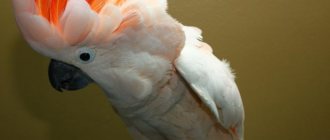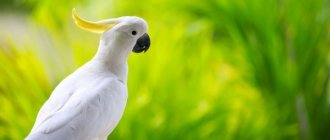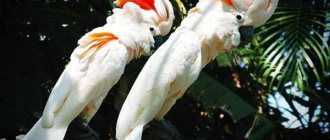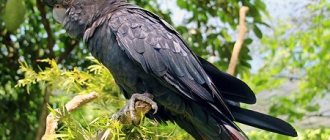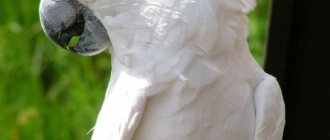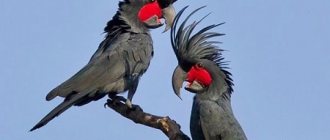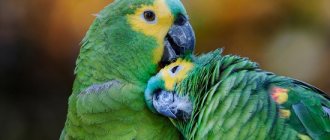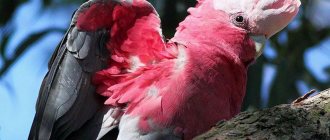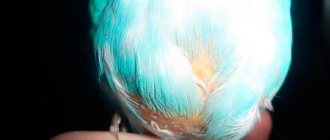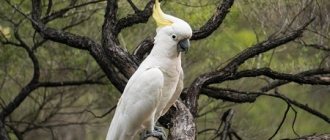The charming, charismatic, talented cockatoo parrot has collected a lot of conflicting reviews. On the one hand, this is a very smart and funny bird that is interesting to communicate with. But at the same time, you need to devote all your time to your pet, since the parrot loves to be the center of attention and painfully endures loneliness. Faced with such a feature of the crested bird, many cannot stand the obsessive temperament. In this article you will receive all the information about the life of a cockatoo in the wild and at home, and also learn how to deal with an impudent ward and raise him correctly.
History of the species
In the scientific classification of birds, the cockatoo family first appeared in the middle of the 18th century, when the French scientist Mathurin-Jacques Brisson proposed the name Cacatua for it, similar to the next step - the genus. Initially, the genus Cacatua contained five species, later 16 more were added to it.
After 1840, the classification underwent changes thanks to the British zoologist George Robert Gray. He placed the cockatoo in the subfamily Cacatuinae of the family Psittacidae. The type taxon became the genus Cacatua.
Currently, there are 21 species of the genus Cockatoo, some of which are listed in the Red Book. The natural habitat is the eastern territories of the southern hemisphere of the Earth: Australia, New Guinea and New Zealand, as well as the Solomon Islands.
The origin of the name “cockatoo” is associated with the peculiarity of the bird’s appearance. The powerful beak, reminiscent of wire cutters, is noteworthy. The Malay word for kusaka is kakatuwah. Naturalists adapted the term they heard, and it entered European languages in the form of “cacatua”.
Constant immutable
In a cockatoo's cage, there should always be mineral supplements in a separate feeder. You can purchase ready-made ones, for example, Triol, Versele-Laga, Vitapol.
If you have time, you can independently collect a mineral mixture for your cockatoo. It may include mineral organic sand, bone meal, feed sulfur, crushed charcoal, eggshells, red clay, corals, chalk, sea shells. In the cage you need to hang sepia (cuttlefish shell) or put rotten wood.
Mineral tiles are also suitable for cockatoos, the production of which we discussed in the article “What to feed a canary.” The composition of the tiles is the same for all indoor birds.
Description of the cockatoo parrot
Each member of the Cockatoo genus is a large, stocky bird with a large head and a dense build.
What does a cockatoo look like?
- Body weight is 300-1200 g depending on the species, age and gender.
- Body size 40-70 cm from beak to tip of tail.
- The parrot's lower limbs are short and stable; wide paws are equipped with sharp curved claws.
- The tail is short in length and rounded or spade-shaped.
- The color of the iris in males is almost black, in females it is red-brown.
A striking feature of the bird’s appearance is its wide curved beak, which folds into a “lock”, like the jaw bucket of a loader. The horny tissue of the beak has an amazing margin of safety. The parrot uses its beak as a third limb or auxiliary tool for movement, protection, and obtaining food.
The “calling card” of a cockatoo is its crest. By the elongated feathers descending from the crown of the neck to the neck, you can easily recognize a cockatoo among other parrots. The crest serves as a way for the bird to express emotions: in a calm state it lies on the back of the head, but if the parrot is excited, the crest unfolds like a fan. In most birds, the crest is a different color from the main plumage.
Did you know? The cockatoo genus is interesting because these parrots lack blue and green feathers. Most colors are based on white, pink and gray, with some species having an accent shade of black.
Habitat
Fans of exotic birds know on which continent cockatoos live. The natural range is limited to Australia and nearby archipelagos. 11 species live on the mainland, representatives of seven species can be found in Indonesia, the Philippines and the Solomon Islands. Three species are found both on the islands of New Guinea and on the continent. The easiest way to say where Goffin's cockatoo lives is that it inhabits only the Tanimbar island group. However, a few individuals were introduced to Singapore, where they multiplied and established a population outside their natural range.
Judging by the distribution area, each species has its own habitat. Some crested parrots choose open landscapes, others live in rain forests, and others prefer urban areas. Indonesian cockatoos live in wetlands. Nomadic species remain in southwestern Australia during the nesting season, and move to cool coastal zones in the summer.
Lifestyle in nature
Cockatoos are characterized by a gregarious way of living. The flock is formed according to the family type, increasing over time due to the emerging offspring. A group of birds moves within the region or leads a sedentary lifestyle. Birds fly well, but move on the ground slowly, with clumsy steps. The parrot climbs trees much faster, clinging with its beak and jumping from branch to branch.
Cockatoos are herbivorous birds. Their diet includes seeds, nuts, fruits and bark of fruit trees, and tubers. Certain species of parrots consume specific foods, while others have a wide menu. For example, the black cockatoo prefers casuarina cones and macadamia nuts. Most crested birds love to feast on corn cobs, making daring raids on farmland. Before the breeding season, all parrots eat insects, larvae, even small rodents.
The parrot eats fruits directly on the tree. It picks the fruit, holds it with its paw, and uses its beak to gnaw out the juicy pulp in search of seeds. The tormented fruit is thrown to the ground and moves on to the next one. To diversify its diet with roots and grass seeds, the bird descends to the foot of the trunk, but feels uncomfortable there. In this regard, the feeding method is curious: while one part of the flock obtains food and fills its crops, the other parrots provide security. Then the groups change.
Nutrition
The basis of parrots' diet is plant food: fruits and fruits, tree bark and branches, grass and its rhizomes, seeds. They can be fed approximately the same in captivity. Grain mixtures, corn, nuts, fruits, berries, and seeds are suitable for such pets. Unsalted porridge, boiled eggs, and cottage cheese are very useful for them.
Of course, each species of such birds has its own characteristics in relation to food. A large blue parrot of the macaw genus, which is simple-minded and sociable in character on the one hand, and touchy and vindictive on the other, has become famous in nature for its pettiness and greed in matters related to the desire to fill its stomach.
If such birds discover tasty seeds, they try to quickly eat them alone and silently, without attracting the attention of their fellow tribesmen, so that they do not get anything. In addition, these birds are lazy, but cunning.
They love palm nuts, which have a soft shell. But in order not to cut this delicacy, they eat it from cow excrement. In the stomach of such animals, the shell is digested, and all the tasty part comes out intact. This is what cunning birds take advantage of.
Reproduction
The ability to procreate in cockatoos appears at the age of 3-7 years, and in males much later than in females. This is a positive factor, because an adult, experienced bird is more reliable in terms of caring for its family. Parrots nest once a year. A pair is formed on the initiative of the male, who touchingly cares for the chosen female: “kisses” her beak, smoothes her feathers, scratches her head. Trying to please his partner, he spreads his tuft, dances and constantly coos.
Having created a pair, the parrots begin building a nest. Natural cavities in large trees are where cockatoos live during the breeding season. The bird cannot independently hollow out a depression inside the trunk, but is able to expand the finished cavity with its beak and paws. For such hollows, the male has to compete with his relatives, and sometimes even evict small animals from their homes.
The male prepares the nest, covering it with twigs, wood chips, leaves, and grass. When the excavation is ready, the female occupies the nest and soon lays two to five eggs. After 20-29 days of incubation, blind chicks appear, covered with sparse down. After 2-3 months, the young begin to fly, but remain under parental care for several years. As soon as parrots mature sexually, they go into independent life, but do not leave the flock.
Inca cockatoo chicks
Interesting observation! There is a strong opinion that cockatoos are monogamous. However, in nature, not all crested parrots create a family for the rest of their lives. Often, after hatching the chicks, the birds lose affection for each other, and the pair breaks up.
A quick way to germinate grains
To quickly and effortlessly germinate grain, first pour it into a convenient container, fill it with water at room temperature (25-27 degrees) and place it in a warm, dry place. After 16-19 hours, when the grains swell, rinse them under the tap.
For this purpose it is better to use a stainless steel sieve. It has the advantage of air ventilation, so the grains do not spoil. And it’s more convenient to wash them in a sieve than in other dishes.
After washing, place the sieve with grains in a dark place. Within 24 hours, the grains need to be washed two or three more times. Carefully monitor their condition, as soon as the white sprouts hatch - the grains are ready for use.
Birds are not very fond of large sprouts, so to slow their growth and prevent souring, place the grains in the refrigerator. Store the sprouted product in the refrigerator for no more than two to three days. Before feeding your cockatoo, heat the kernels in the sun or in a water bath.
Cockatoo species
There are 21 species in the Cacatuidae family, each of which is characterized by a specific color.
The most famous species of cockatoos with descriptions:
- Great yellow-crested. One of the largest in the family. The size of the bird tends to 50 cm, weight is about a kilogram. The feathers are white with a golden tint, and the narrow crest is yellow. The parrot learns well and performs complex tricks. He is popular due to his outstanding abilities: he can change his voice beyond recognition, reproduce various sounds and melodies.
Greater yellow-crested cockatoo - Great white-crested (Alba white cockatoo). The bird is medium in size - approximately 40 cm and 600 grams. Snow-white plumage covers the entire body. There is a wide white crest with rounded tips, similar to a flower bud. The intelligent parrot is incredibly artistic and can imitate human speech.
Great white-crested cockatoo - Pink (Gala cockatoo). Better known by the names "clown" or "fool", which he was given for his strange behavior. The back and wings are gray, the belly, head and neck are red. The crest is light pink. It grows up to 35 cm. A bird with a peaceful character easily adapts in captivity. Pink cockatoo
- Inca Cockatoo (Major Mitchell's Parrot). The most beautiful representative of the family. It has a luxurious variegated crest, which when unfolded resembles a bright fan or flower. The feathers of the “crown” are red, with yellow spots in the middle, and the tips are white. Body color is white and pink. It is prohibited to export it outside of Australia, and within its natural range, breeding in captivity is possible only under special regulations.
Inca cockatoo - Black palm. The largest and grandest. Completely black, except for the leathery red cheeks. The high crest consists of narrow curled feathers. It is the oldest species of cockatoo living in Australia and is also an extremely rare bird - likely to become extinct in the coming years due to habitat loss and low reproductive rates.
Black palm cockatoo - Banks' mourning cockatoo. A black parrot with white markings in a mottled pattern. The underside of the tail is half red in males, with orange stripes in females. In addition, females have black feathers on their chest and belly with an orange border.
Banks' mourning cockatoo
The other parrots are also beautiful, each in their own way. Several species of these exotic birds are endangered. Five species have conservation status in Appendix I Cites: Goffin's cockatoo, Moluccan cockatoo, red-tailed cockatoo, yellow-crested cockatoo and palm cockatoo.
Strict dosage of fats
Cockatoos love nuts. But no matter how much you would like to treat them with a nutty treat, do this no more than twice a week, five to seven pieces per bird. At the same time, reduce the volume of sunflower seeds, otherwise the birds will quickly get fat. Obesity is the cause of malfunctions in the internal organs of cockatoos, which in a neglected state lead to death.
Of the variety of nuts, cockatoos include walnuts, palm trees, peanuts, and pine nuts. Any type of nuts must be raw, without salt or sugar.
There is no need to remove the shells from the nuts before serving - the parrots will do this themselves. It is enough to prick them slightly. It is not recommended to chop nuts in reserve. They may become bitter. You can pre-roast the peanuts. Then, when peeling, the shell will crunch, which the cockatoo really likes.
Intelligence
In the parrot family, the cockatoo is considered one of the most intellectually developed. He has a good memory, a logical mind, and conversational talent.
Epithets characterizing cockatoos:
- Cunning. He can pick a complex lock, steal and hide an important thing, do something nasty, and then pretend that he is not guilty. Can solve puzzles. Capable of cunningly luring out a treat, even if punished.
- Revengeful. He remembers the evil done to him and returns it in an increased size. Being offended, he does not make contact, refuses food, ignores toys and treats.
- Talkative. He is still able to remember and pronounce a few dozen words, but this parrot speaks much worse than the gray parrot. However, the desire exceeds the ability, and the cockatoo bird chatters incessantly - “what I see, I sing.” She is much better at imitating animals and reproducing various noises.
- Sentimental. There is no parrot more gentle and affectionate than a cockatoo. This can be compared to the manifestations of a dog’s feelings for its owner. You need to see how the bird climbs to hug its owner and courtes the object of its love in every possible way - nothing could look more touching!
- Affectionate. He never gets enough attention from his owner. The parrot wants to participate in everything. To tame the pressure of the bird, breeders recommend getting a second cockatoo - in this case, the emphasis should shift to a partner.
- Demonstrative. If the bird doesn’t like something, it will scoop up food from the container by the handful and throw it to the bottom of the cage. After cleaning carried out by the owner, he deliberately tears the paper, scatters greens around the cage, and drops droppings wherever necessary. He shows dissatisfaction with his entire appearance: he spreads his crest, puffs up his wings, tilts his head, hisses.
- Loud. Expresses emotions very loudly. It is worth noting that cockatoo owners often have problems with their neighbors. Such a noisy bird is difficult for everyone around to tolerate. It only becomes silent in complete darkness.
- Careless. In games, in a fit of emotion, he does not restrain himself - he can bite painfully, hit with his paw or wings. Perhaps everyone who has a cockatoo in their home has “battle” scars received from their pet.
On a note! The cockatoo is an excellent manipulator. He notices the owner’s weaknesses and uses his knowledge with pleasure. Can express demands by shouting until he gets what he wants.
Peculiarities of habits
Temperament and curiosity are the main characteristics of cockatoos. When kept at home, this transforms into love and mischief. The first is accompanied by either frequent repetition of the name (oneself or the owner - it doesn’t matter), or frantic screams when emotions overwhelm.
Sabotage activities take place in complete silence, because cockatoos understand perfectly well what they will be praised for and what they will be scolded for. Therefore, you need to keep in mind: if a parrot is silent during the day, it is either sick or damaging your property.
But nature takes its course, so if you want to prevent your cockatoo from becoming a hypochondriac and hysterical (especially for males), make him a spacious cage and equip it with a very reliable lock.
Why shouldn't you get a cockatoo?
Otherwise, one not very beautiful morning you will find that your cute parrot is sitting in his open cage, as if nothing had happened, and in the room there is a painting “We took a walk...”
These include chewed baseboards with torn wallpaper, damaged furniture and shoes, and in the most tragic cases, broken wiring.
At the same time, the cockatoo himself looks completely satisfied and pretends that he does not understand what expenses he has put you through. And he sticks his head out: pet me, I’m good.
If your parrot has a tendency to escape, do not skimp on the quality of the cage material. The powerful beak of a cockatoo will allow it to bite through a wire that is not stiff enough and cut a window into the free world for itself without much effort.
Sometimes cockatoos have bouts of bad mood. This can be determined by unusual behavior. At such a moment, it is better to serve him his favorite treat, but very carefully, and under no circumstances try to pet him. They bite mercilessly and without any warning. In this case, the person receives very serious injuries.
https://www.youtube.com/watch?v=jquTyqszrjA
It has been noted that the larger the bird, the louder the sounds it makes.
Keeping at home
As the experience of breeders shows, cockatoos can be successfully kept at home. A large feathered pet requires different conditions than ordinary lovebirds or budgies. When planning to get a large, capricious bird, you need to carefully consider the nuances of care and maintenance. First of all, you should prepare the cage.
Arrangement of the cage
One cockatoo takes up as much space as a small flock of budgerigars. Therefore, a medium-sized cage will not work. A reinforced overall structure is needed. In a spacious cage or enclosure, you can place more accessories: install a container with soil and plant a low tree, lay out driftwood and spreading branches.
A few tips:
- It is important that the feeders and drinking bowls are of increased strength, preferably made of steel, otherwise an active parrot will break them.
- Plastic panels (aprons) around the perimeter of the cage will help prevent debris from falling apart.
- Waste accumulates at the bottom of the structure, which can be conveniently removed using a pull-out tray.
- Bird apartments have significant weight; for ease of movement, an element such as wheels is important.
In the absence of a person, the parrot needs to play, and for this it will need a stand and entertainment items made from natural materials: jute fiber, wood.
Nutrition
The diet of a large parrot should contain dry and juicy components in a ratio of 1:3. Unlike small parrots, cockatoos feel full for much longer - they accumulate food in their voluminous crop, which is slowly digested. The parrot needs to be fed thoroughly twice a day and given snacks several times.
At home, birds are fed dry mixtures for large parrots. Factory-made feed consists of millet, sunflower seeds, safflower, oats and other grains with a high content of proteins and carbohydrates. Fruits, boiled and raw vegetables are necessary for the wards, as is cereal food. They contain plant fibers, vitamins, and minerals. Cockatoos love berries, corn cobs, fruits with seeds - such foods are also entertainment for them.
Care and hygiene
A large cockatoo parrot is constantly busy with something, after this activity everything around is strewn with garbage. Caring for a pet often comes down to constant cleaning. To make your work easier, equip the cage with special panels and a pull-out tray. This way, all the dirt will remain inside the cage, and during cleaning you can brush it off the tray and wash it. Feeders are washed twice a day and then thoroughly wiped dry. The perches are cleaned dry; they should not be washed frequently, otherwise the tree will swell.
The care rules include regular bathing of the bird itself. Cockatoos love water; they are happy to put their heads under the spray of a sprayer, climb under the shower and open tap. There is no need to deny your pets their favorite pastime, but it is not recommended to deliberately immerse birds in water.
Important addition! Cockatoo feathers are covered with a special powdery coating that easily scatters over all surfaces. This pollen is a protective barrier for the bird, so frequent water procedures are undesirable.
Education and training
You need to tame and raise a cockatoo parrot from an early age. If you are lucky enough to purchase a foster chick, it should already be tame. In the first days, it is not advisable to approach a new pet unless necessary. At this stage, you should simply be in front of the parrot - mind your business not far from the cage. At this time, the bird watches the owner and gradually gets used to it. After the adaptation period is over, you can begin training. This is a long process, the result of which will disappoint or delight, depending on the character and abilities of the bird.
The cockatoo subtly senses the owner’s mood, is easily offended and withdraws from communication. The carrot and stick method does not work on him. A good attitude, tenderness, and openness have a good effect. However, excessive affection can also cause harm. It is necessary to clearly stop the bird’s incorrect behavior in a stern voice, but in no case should physical punishment be used. Remember - the cockatoo is incredibly touchy and vindictive.
Lifespan
The cockatoo parrot is considered a long-lived bird. It is not possible to calculate the average life expectancy in nature, but there is an assumption that it is approximately one and a half decades. After all, birds in the wild have many enemies, and in addition, from time to time entire flocks of parrots die from infectious diseases. Cockatoos live next to humans in good conditions for 40-50 years.
Diseases and causes of death
At home, the parrot is reliably protected from predators, fires, floods and crop failure. How long a tame cockatoo will live depends only on the owner and his family members.
Cockatoo diseases have a viral, bacterial or parasitic origin, but much more often parrots suffer from improper feeding or mechanical damage. A fairly common phenomenon is self-plucking, which highly intelligent parrots are prone to. In rare cases, there is a genetic disease that cannot be corrected.
Self-plucking in cockatoos
The cockatoo is an expensive parrot, and its treatment, accordingly, is not cheap. Caring for a sick parrot is quite difficult, and it is not always possible to avoid death. It will be easier for everyone if you prevent the development of the disease, and for this you need to contact a veterinarian at the first symptoms and do not forget about preventive examinations.
The death of a domestic cockatoo parrot most often occurs as a result of the owner's oversight.
Main causes of death:
- poisoning;
- burn;
- swipe;
- strangulation;
- pet attack.
The most unpredictable and mysterious factor that accelerates the death of a bird is depression. From the resulting stress, the cockatoo loses interest in life, refuses food, plucks its feathers to bare skin and gradually fades away.
Breeding
Breeding rare species of parrots at home requires considerable investment, as well as a lot of free time. The breeder must be immersed in the process and ready to come to the aid of the birds at any time. The female may experience difficulties during childbirth and other troubles. In addition, newborn chicks often have to be taken away from their parents and fed formula from the first days. Chicks raised by humans grow up tame and trusting.
Cockatoo chicks
Breeding rare birds as a business is a profitable business, but extremely responsible and complex.
Expert advice
Breeders who work closely with nipper parrots recommend weighing the pros and cons before purchasing. Perhaps, from the outside and in the video, the “clown” with a tuft seems cute, but this is just a beautiful picture. You won’t envy the people who live in the same territory as this capricious bird. They have to face various problems every day; When communicating with a Velcro parrot, a stable psyche is required. You need to be able to pacify the winged aggressor and educate him correctly.
Cockatoo parrot with friend
The main advice from an ornithologist is that when communicating with a bird you need to notice all the little things. Monitor changes in behavior in order to promptly correct the character and prevent the pet from feeling like the master of the situation. The subject of a home living corner, although he is the youngest member of the family, is obliged to know his place. Then living together will please both parties.
How much does it cost and where to buy
You can buy an exotic decorative parrot with a crest without any problems. Cockatoos of common species are sold by private breeders and nurseries; Even large pet stores sell crested birds. Buying a bird in such places is quite risky, because there is no guarantee of health or compliance with the stated age and gender. For private sellers, the cost of birds averages 50-100 thousand rubles.
Helmeted Cockatoo
Specialized nurseries sell rare birds, bred independently or imported from European countries. Professional breeders comply with the regulations and provide the buyer with the necessary documents and test results. A cockatoo parrot from a nursery will definitely have a permanent ring on its paw or a veterinary chip. Several factors influence the price:
- origin;
- breed;
- age;
- floor;
- color;
- feeding method.
A white cockatoo costs about 90 thousand rubles, a yellow-crested cockatoo costs from 150 thousand rubles. Parrots of rarer species are sold at prices ranging from 500 thousand to a million rubles.
What is the appeal of the cockatoo parrot?
Breeders love cockatoos for their sociability and lively intelligence. Some bird habits delight children and adults: playing with the crest, bowing, squatting, courtship, dancing. An attentive and inquisitive parrot quickly learns to perform funny tricks and pronounce words.
Cockatoos become tightly attached to people, literally following on their heels. They appreciate care and experience separation dramatically. From interacting with a parrot you can get emotional satisfaction, joy and a positive atmosphere in the house.
When choosing a cockatoo as a pet, many do not understand what they are getting into. A capricious bird requires complete dedication, and without this its character deteriorates. And yet, the cockatoo is a companion bird, ready to become a devoted friend to a person for life.
What is a bird
The cockatoo is a sociable and intelligent bird that requires difficult care. This is a flocking creature, therefore, at home, a person is perceived by him as a member of the flock, and the parrot communicates with him, which is expressed in sounds, gestures and facial expressions, as far as this is applicable in this case.
Before purchasing a cockatoo, you need to think carefully about whether it can receive proper care and attention, and whether the owner has the intelligence and ingenuity to stop attempts at vandalism by the pet.
Introduction to the Cockatoo parrot
